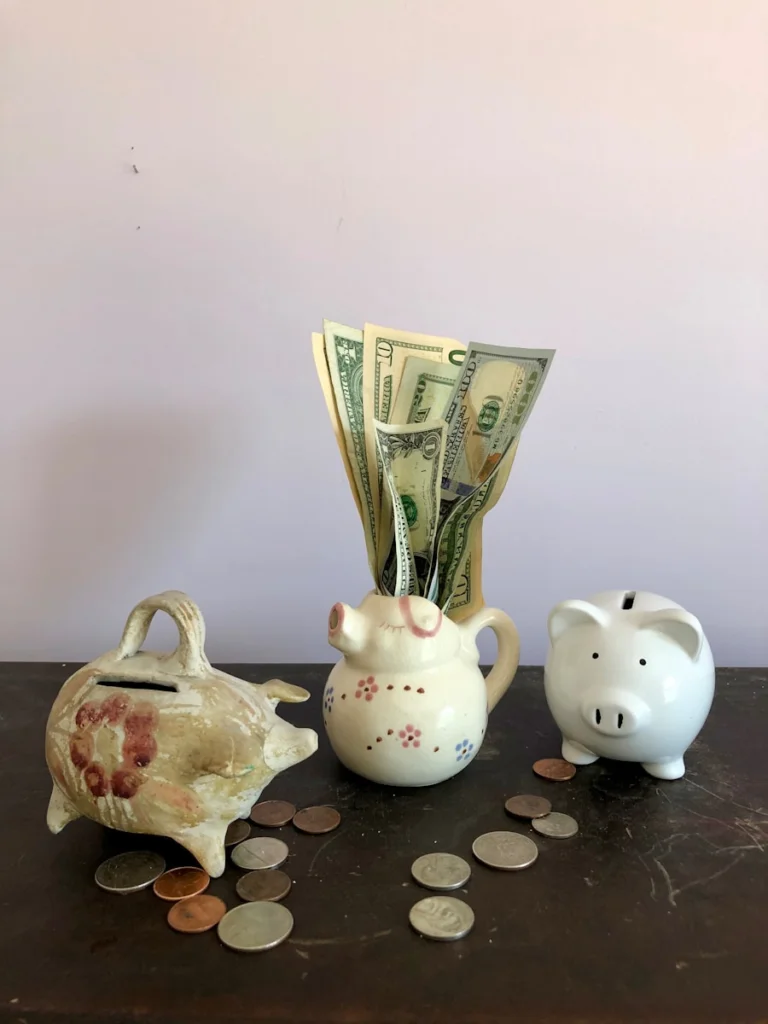
You might not realize that your brain releases dopamine when you hit savings milestones, making money challenges surprisingly addictive in the best way possible. That’s why these 15 creative savings challenges work so well – they hack your natural reward system while building serious financial discipline. Whether you’re starting with loose change or tackling bigger monthly goals, there’s a perfect challenge that’ll match your lifestyle and turn saving into something you actually look forward to doing.
The 52-Week Savings Challenge
The 52-Week Savings Challenge transforms the formidable task of saving money into an exciting year-long journey. You’ll start by saving $1 in week one, $2 in week two, and continue increasing your weekly deposit by one dollar. By week 52, you’ll save $52, accumulating $1,378 total!
You control the pace and timing. Set up an automatic transfer to remove temptation and maintain consistency. Some people prefer reverse order, starting with $52 when motivation runs high. Others break it into monthly contributions, depositing roughly $110-115 each month instead of weekly amounts.
The challenge’s beauty lies in its flexibility. You can double the amounts for $2,756 savings or halve them if money’s tight. This progressive approach builds momentum while developing powerful saving habits that’ll serve you beyond the initial year. Consider channeling your accumulated savings into launching a small business idea that requires minimal startup capital, potentially generating additional income streams.
The $5 Bill Challenge

The $5 Bill Challenge offers a simple twist on saving that feels almost effortless. Every time you receive a five-dollar bill as change, you’ll set it aside instead of spending it. To maximize your success, consider using automatic transfer features to move the equivalent amount from your checking account to a dedicated savings account each time you collect a five-dollar bill.
Let’s explore how this challenge works, the best ways to track your growing savings, and smart strategies to boost your results!
How It Works
Whenever you receive a $5 bill as change, you’ll simply set it aside instead of spending it. The simplicity factor makes this challenge incredibly powerful—there’s no complex math or tracking required. You’re taking control of your financial future with each bill you save.
The commitment aspect kicks in when you treat every $5 bill as off-limits for spending. Store them in a jar, envelope, or special savings account. You’ll be amazed how quickly these bills accumulate! Most people receive $5 bills several times per month through everyday purchases.
This challenge works because it removes decision-making from the equation. You’re not debating whether to save—you’re automatically saving every time. Within six months, you could easily have $200-400 saved without feeling the pinch.
Tracking Your Progress
Success with your $5 bill challenge depends on monitoring how much you’ve saved along the way. You’ll want to establish clear tracking goals from the start. Set milestones like reaching $100, $250, or $500 to maintain momentum and celebrate victories.
Create a simple tracking system that works for you. Mark each $5 bill on a visual chart, use a smartphone app, or maintain a basic spreadsheet. The key is monitoring performance consistently so you see tangible progress.
Check your savings jar weekly and record the total amount. This regular review keeps you motivated and accountable. When you visually track each deposit, you’ll feel empowered watching your balance grow. Recall, successful savers don’t just collect money—they actively monitor their progress toward financial goals!
Maximizing Your Results
Several smart strategies can help you collect $5 bills faster and boost your overall savings results. You’ll build powerful habit formation patterns that make sustainable savings feel effortless and rewarding.
Transform your $5 challenge into a money-making machine with these proven tactics:
- Request $5 bills at banks – Ask tellers to include several fives in your cash withdrawals
- Break larger bills strategically – Use twenties for purchases that’ll return fives in change
- Set weekly collection goals – Aim for 2-3 bills weekly to maintain momentum
- Create visual reminders – Place collection jar where you’ll see it daily
- Track milestone celebrations – Reward yourself at $50, $100, and $200 marks
You’re building wealth through small, consistent actions. Each five-dollar bill represents your commitment to financial success and creates lasting money habits that’ll serve you for years.
The Spare Change Challenge
The spare change challenge transforms your pocket coins and leftover dollars into a surprising savings fund. You’ll harness one of the most effective micro savings methods by collecting every coin and small bill that crosses your path.
Start by placing the loose change jar in a prominent spot where you’ll see it daily. Every time you come home, empty your pockets completely. Add dollar bills under five dollars to maximize your results. You’ll be amazed how quickly those seemingly worthless coins accumulate into real money.
Set a timeline of three to six months before counting your treasure. Most people save between $50 and $200 using this simple strategy. You’re building wealth from money you’d normally overlook, proving that small actions create powerful financial momentum.
This tangible approach to saving mirrors how cash envelope budgeting transforms abstract financial goals into physical money management that you can touch and control.
The No-Spend Weekend Challenge
Your next money-saving adventure involves keeping your wallet closed for an entire weekend. You’ll need to get creative with free activities, resist those “just this once” spending urges, and keep track of every dollar you would’ve spent.
This challenge typically saves people $50-150 per weekend while showing you how much unconscious spending happens during your downtime! Plus, you can combine this with time in nature by exploring local parks, hiking trails, or having a picnic in your backyard – activities that naturally reduce stress while keeping your budget intact.
Planning Your Weekend Activities
When Friday afternoon rolls around, most people automatically think about spending money on weekend entertainment. You can break this expensive habit by taking control of your weekend plans. Smart planning transforms your no-spend challenge from restrictive to exciting!
Start by researching free opportunities in your area. Planning a picnic costs practically nothing but delivers maximum enjoyment. Attending local events often provides entertainment without the price tag. You’ll discover amazing activities you never knew existed.
Here are five powerful weekend activities that cost zero dollars:
- Visit free museums on community appreciation days
- Explore hiking trails and nature parks
- Host potluck game nights with friends
- Attend free outdoor concerts and festivals
- Create art projects using household materials
Strategic planning puts you in complete control of your entertainment budget while maximizing fun.
Overcoming Spending Temptations
Tempting spending opportunities lurk around every corner during weekends, but you can develop bulletproof strategies to resist them. The No-Spend Weekend Challenge transforms you into a master of avoiding impulse purchases while building willpower that lasts.
Start by removing shopping apps from your phone and leaving credit cards at home. Create a list of free activities like hiking, reading, or visiting parks. When you feel the urge to buy something, wait twenty-four hours before purchasing.
Track every dollar you don’t spend during your challenge weekend. You’ll discover that building willpower becomes easier with practice! Many people save $50-$150 during their first no-spend weekend. Replace shopping habits with creative hobbies or social activities that don’t cost money. Your future self will thank you.
Tracking Money Saved
Recording exactly how much you don’t spend transforms your no-spend weekend from a vague goal into a measurable victory. You’ll discover real power when you see those dollars staying in your account instead of disappearing.
Smart budgeting techniques make tracking effortless and rewarding:
- Screenshot your bank balance Friday evening and Monday morning to compare
- Use savings app integration to automatically log weekend deposits
- Create a simple spreadsheet noting each avoided purchase and its cost
- Set up automatic transfers for saved amounts into dedicated savings accounts
- Take photos of items you almost bought but didn’t
You’ll feel incredible momentum when you see $50, $100, or even $200 staying put in your accounts. This concrete proof of your financial discipline builds confidence for bigger money challenges ahead.
The 365-Day Penny Challenge

Building up your savings becomes incredibly simple when you start the 365-Day Penny Challenge. You’ll deposit one penny on day one, two pennies on day two, and continue increasing by one penny daily. By year’s end, you’ll have saved $667.95!
The penny jar method works because it starts small and builds momentum gradually. You won’t feel overwhelmed by large amounts early on. Creating a visual tracker helps you stay motivated and see your progress clearly. Mark off each day as you make your deposit.
This challenge puts real power in your hands. You’re taking control of your financial future one penny at a time. The gradual increase makes it manageable, even when you reach the final months. You’ll be amazed how those tiny contributions add up to serious money! Just like gratitude journaling transforms your brain’s wiring for positive emotions, this daily savings habit rewires your relationship with money for long-term financial success.
The Weather Wednesday Challenge
When Wednesday rolls around each week, you’ll check the weather forecast and save money based on the temperature! This challenge puts you in control by connecting your savings to nature’s patterns.
Here’s how you’ll dominate this challenge:
- Save the temperature in cents (72°F = $0.72)
- Double your savings on days above 90°F or below 32°F
- Add $1 extra during major weather events like storms
- Track weather patterns to predict your monthly savings
- Celebrate seasonal changes with bonus contributions
You’ll discover that weather patterns create natural saving rhythms throughout the year. Summer heat waves boost your account, while winter freezes double your deposits. This approach transforms unpredictable weather into predictable wealth-building momentum. You’re not just saving money—you’re mastering consistency while staying connected to seasonal changes that make each Wednesday exciting! The money you accumulate through this weather-based challenge can be redirected toward building wealth-building activities instead of disappearing into impulse purchases and unnecessary expenses.
The Meal Planning Money Challenge
While weather connects your savings to nature’s rhythms, your kitchen holds even greater potential for building wealth through smart planning. The Meal Planning Money Challenge transforms your grocery budget monitoring into a powerful wealth-building tool.
You’ll track every dollar spent on food for one month, then challenge yourself to cut 20% through strategic meal prep planning. Start by documenting your current spending, then create weekly menus using ingredients you already own.
| Week | Grocery Spend | Meals Prepped | Savings Goal |
|---|---|---|---|
| 1 | $150 | 5 | $30 |
| 2 | $140 | 7 | $28 |
| 3 | $130 | 10 | $26 |
| 4 | $120 | 12 | $24 |
This challenge puts you in complete control of one of your largest variable expenses, building discipline that extends far beyond your kitchen. By reducing restaurant spending and focusing on home-cooked meals, you’re moving money from the wants category into your savings, creating a sustainable approach to building wealth through everyday choices.
The Entertainment Swap Challenge

After mastering your kitchen budget, your entertainment expenses offer another goldmine of savings opportunities. You’re about to discover how entertainment budget planning can slash your monthly spending by $200 or more through strategic entertainment activity swap techniques.
Entertainment budget planning can slash your monthly spending by $200 or more through strategic activity swaps.
Instead of abandoning fun completely, you’ll replace expensive activities with equally enjoyable alternatives that cost substantially less:
- Swap movie theater visits ($15 each) for outdoor movie nights using your laptop
- Replace expensive concerts with free local music festivals and community events
- Trade costly restaurant dinners for potluck parties with friends
- Exchange pricey gym memberships for hiking trails and YouTube workout videos
- Substitute shopping trips with free museum days and library events
You’ll maintain your social life while building serious wealth. This challenge transforms entertainment from a budget killer into a creativity booster! Start by conducting a time audit to identify exactly where your entertainment dollars are going each week, tracking every expense to reveal the biggest opportunities for strategic swaps.
The 30-Day Minimalism Challenge
You’ll transform your living space and boost your bank account by removing one item from your home each day for thirty days. Track every dollar you save by resisting new purchases and note the cash you earn from selling items you no longer need.
This challenge helps you discover how much money you’ve been spending on things that just create clutter! Consider converting old clothes into cleaning rags to replace expensive paper towels and reduce your monthly household supply costs.
Daily Decluttering Rules
The 30-Day Minimalism Challenge combines decluttering with saving money in a brilliant way that’ll transform both your space and your wallet. You’ll follow a simple daily decluttering schedule that builds momentum over thirty days.
Here’s how your decluttering schedule works:
- Day 1: Remove 1 item, Day 2: Remove 2 items, continuing this pattern
- Sell valuable items online through Facebook Marketplace or eBay
- Donate other items and claim tax deductions
- Take photos of sentimental items before letting them go
- Set aside all proceeds in a dedicated savings account
You’ll gain control over your environment while building wealth. By day 30, you’ll have removed 465 items total! Most people save $200-500 from sales alone. This daily decluttering approach prevents overwhelm while creating lasting habits that stick.
Money Saved Tracking
While decluttering creates amazing physical changes, tracking your financial wins keeps you motivated throughout the entire challenge. You’ll discover real power when you see those dollar amounts adding up daily.
Create a simple spreadsheet or use your phone’s notes app to record every item’s estimated value. Write down what you didn’t buy because you already owned something similar. This becomes your personal expense tracking system that reveals spending patterns you’ve never noticed before.
Your newfound awareness transforms into powerful budgeting strategies. You’ll start questioning purchases before making them, asking “Do I really need this?” Track everything from the $15 shirt you didn’t buy to the $200 gadget gathering dust.
Selling Unwanted Items
Turning your decluttered items into cash creates the perfect win-win situation for your wallet and living space. You’ll discover that listing unwanted items becomes surprisingly profitable when you know where to look. Start by identifying valuable pieces you’ve overlooked, then choose the right platforms for maximum returns.
Focus on these high-value categories for quick sales:
- Electronics like phones, tablets, and gaming consoles
- Designer clothing and accessories in good condition
- Books, especially textbooks and first editions
- Kitchen appliances you never use
- Furniture pieces that don’t fit your style
Selling collectible items requires research, but the payoff can be substantial. Set a goal to earn $500 in thirty days through strategic selling. You’ll build momentum while funding your savings goals effortlessly!
The Cashback Rewards Challenge

Since many credit cards and apps already offer cashback rewards, you might as well turn those earnings into a focused savings strategy! This challenge transforms your regular spending into powerful cash flow management. You’ll maximize every purchase while building your savings account.
Start by choosing high-reward categories and track your earnings monthly. Set a specific goal, like earning $300 in cashback within six months. This approach enhances your budgeting strategies by making every dollar work harder.
| Month | Cashback Earned | Category Focus | Running Total |
|---|---|---|---|
| 1 | $45 | Groceries | $45 |
| 2 | $52 | Gas & Dining | $97 |
| 3 | $38 | Online Shopping | $135 |
You’ll be amazed how quickly those rewards add up when you’re intentional about earning them! Consider focusing your cashback strategy on categories like groceries, which should consume 12-15% of monthly income, or fuel expenses where the average person spends $2,109 yearly, making your transportation expenses work double duty for your savings goals.
The DIY vs. Buy Challenge
Another powerful way to boost your savings involves questioning every purchase decision you make. The DIY vs. Buy Challenge transforms you into a smart consumer who weighs options before spending. This comparison of DIY vs. buying puts you in control of your financial destiny.
Transform every purchase into a strategic decision that empowers your financial future through thoughtful comparison shopping.
Before purchasing anything over $20, pause and research alternatives. Evaluating cost savings of DIY projects often reveals shocking differences. You’ll discover which items deserve your DIY attention and which you should simply buy.
Consider these common scenarios:
- Home repairs: YouTube tutorials vs. contractor quotes
- Gifts: Handmade items vs. store-bought presents
- Meals: Cooking from scratch vs. takeout orders
- Cleaning supplies: Homemade solutions vs. branded products
- Garden maintenance: DIY landscaping vs. professional services
You’ll develop powerful decision-making skills while padding your savings account!
The Monthly Bill Audit Challenge

While most people set their bills on autopay and forget about them, you’re about to become a savings detective who uncovers hidden money in plain sight. This monthly subscription review transforms you into a financial powerhouse who controls every dollar flowing out of your account.
Start your utility bill analysis by gathering three months of statements. You’ll spot patterns and identify opportunities for negotiation or plan changes.
| Bill Type | Action Needed | Potential Savings | Time Required |
|---|---|---|---|
| Phone/Internet | Compare competitor rates | $20-50/month | 30 minutes |
| Streaming Services | Cancel unused subscriptions | $10-30/month | 15 minutes |
| Insurance | Request quote comparisons | $50-200/month | 45 minutes |
| Utilities | Negotiate payment plans | $15-40/month | 20 minutes |
Schedule this challenge monthly to maintain your financial edge and maximize savings!
The Seasonal Savings Challenge
As seasons change throughout the year, your spending patterns shift dramatically, creating perfect opportunities to save money on predictable expenses. You can harness these natural cycles to build your financial strength systematically.
The holiday savings challenge transforms your biggest spending season into a strategic advantage. Start saving $25 weekly in January, and you’ll have $1,300 ready for December festivities. The winter savings challenge focuses on reducing heating costs and holiday aftermath expenses.
Master these seasonal patterns:
- Track your seasonal spending for three months to identify patterns
- Automate savings transfers based on upcoming seasonal needs
- Negotiate better rates on utilities before peak usage seasons
- Stock up on discounted items during off-season sales
- Create dedicated savings accounts for each major seasonal expense
You’ll control your money instead of scrambling when seasons shift.
The Habit Stacking Money Challenge
You can supercharge your savings by connecting money goals to things you already do every day. When you stack multiple money habits together, like saving $2 every time you brush your teeth or check social media, you’ll build powerful financial routines without thinking about it!
The key is tracking your progress daily so you can see how these small, consistent actions add up to real money over time.
Link Savings to Routines
Stacking new savings habits onto your existing daily routines creates an effortless path to building wealth. You’re already brushing your teeth, making coffee, and checking your phone—why not trigger automatic savings during these moments?
When you link savings to morning routines, you’ll start each day building your financial future. Set up transfers that happen while you’re drinking your first cup of coffee. You can also link savings to evening routines by moving money to your savings account right after dinner.
Here are powerful ways to stack savings habits:
- Transfer $5 every time you brew morning coffee
- Save $10 after your evening workout session
- Move spare change when you plug in your phone to charge
- Deposit $3 after brushing your teeth at night
- Save $7 when you turn off the TV
Stack Multiple Money Habits
Once you’ve mastered linking one savings action to each routine, you’re ready to multiply your results by combining several money habits together. Stack multiple wins by creating powerful habit chains that work automatically.
Set up recurring deposits on payday, then immediately transfer your coffee money to savings. When you check your phone each morning, review yesterday’s spending and move any unspent budget dollars to your emergency fund. After dinner, round up your daily purchases and schedule transfers for the difference.
This stacking approach creates momentum that compounds your success. You’re not just saving once – you’re building a system of multiple touchpoints throughout your day. Each completed action triggers the next, making it harder to skip and easier to stay consistent. Your financial power grows with every stacked habit.
Track Your Progress Daily
Success with habit stacking comes down to one simple practice that most people skip completely. Visual tracking transforms your money habits from wishful thinking into concrete results you can see and celebrate.
Daily progress monitoring keeps you laser-focused on what’s working. You’ll spot patterns, catch slip-ups early, and build unstoppable momentum toward your financial goals.
Here’s how to track like a champion:
- Use a simple chart or phone app to log each completed habit
- Mark your wins with colorful checkmarks or gold stars
- Take photos of your growing savings balance weekly
- Set daily reminders to review your progress at the same time
- Share updates with an accountability partner who cheers you on
You’ll be amazed how this simple practice accelerates your success!
The Visual Progress Challenge
Seeing your progress unfold before your eyes can transform saving money from a chore into an exciting game. You’ll harness the power of visual representation to fuel your motivation and maintain momentum toward your financial goals.
Create a savings thermometer on your wall, coloring in sections as you reach milestones. You’re building the reward system that keeps you engaged and excited about each dollar saved. Consider using a clear jar where you can watch your cash pile grow, or design a chart that tracks your journey from $0 to your target amount.
The visual impact is immediate and powerful. You’ll see exactly how far you’ve come and how close you’re to victory. This tangible progress creates unstoppable momentum that drives you forward.
Conclusion
You’ve got nine powerful savings challenges at your fingertips! Like a gardener who plants different seeds throughout the year, you’ll watch your money grow from various sources. Sarah from Ohio started with just the spare change challenge and saved $847 in her first year. Pick one challenge that excites you most, then add another after two months. Your future self will thank you for starting today!





Leave a Reply